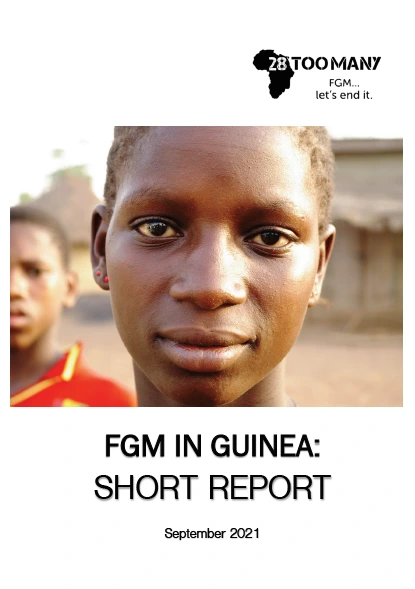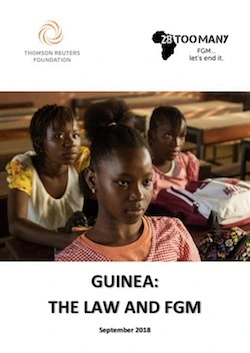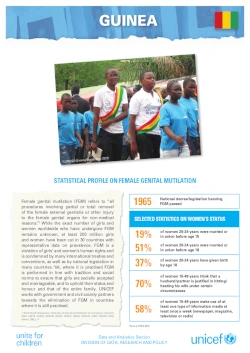Home | Research & Resources | Guinea
Key Findings
The prevalence of FGM/C among women aged 15–49 in Guinea is 94.5%.
Medicalised FGM/C is on the rise: medical professionals cut about 17% of women aged 15–49, but almost 35% of girls aged 0–14.
Geography
FGM/C remains consistently high across the country; the highest and lowest prevalences are in the regions of Kindia (98.4%) and N’Zérékoré (84.0%)
Age
65.1% of women aged 15–49 who undergo FGM/C are cut between the ages of 5 and 14
Type
‘Cut, flesh removed’ is the most common type of FGM/C practised, but more than one in five women don’t know what type of cut they’ve had
Agent
Overall about 78% of women are cut by traditional practitioners, but medicalised FGM/C is rising rapidly
Distribution of FGM/C across Guinea
The prevalence of FGM/C among women aged 15–49 in all administrative regions of Guinea remains high. The highest prevalence is in Kindia (98.4%) and Labé (98.2%). N’Zérékoré, which is located in the south-east and contains the second-largest city in the country, has the lowest prevalence at 84%. There is, however, almost no difference between the prevalence of FGM among women aged 15–49 who live in rural areas (94.3%) and those who live in urban areas (94.8%).
FGM is practised by people from all major religious and ethnic groups in Guinea. The ethnic groups with the highest prevalence of FGM/C among women aged 15–49 are the Soussou (97.9%) and Peulh (97.3%). The ethnic groups with the lowest recorded prevalences of FGM/C are the Kissi (88.2%), the Guerzé (77.8%) and the Toma (69.3%). However, of the Toma, a relatively small number of women were interviewed, so this should be interpreted with caution. Muslim women aged 15–49 are more likely to be cut (97.1%) than Christian women (77.9%) or women of no religious affiliation (85.3%).
Overall, 65.4% of women and 59.6% of men aged 15–49 who have heard of FGM/C believe that the practice should be continued. Support for the continuation of FGM/C is highest in rural areas and among those with lower levels of education. 55.8% of women and 64.3% of men believe that FGM is a requirement of their religion.
Trends in FGM Prevalence in Guinea
Over the past two decades in Guinea there has been a very small (but statistically significant) decline in the overall FGM/C prevalence among women aged 15–49 (from 98.6% in 1999 to 94.5% in 2018).
Prevalence of FGM/C in women aged 15–49 remains high, however, across all age groups. The prevalence in women aged 15–19 is around three percentage points lower than in women aged 20–24. It should be noted, though, that women aged 15–19 are still at risk of being cut (around 4% of women who had been cut report that it happened after the age of 15); therefore, this statistic should be interpreted with caution.
FGM/C Legislation in Guinea
The Guinean Government originally passed anti-FGM/C legislation in 1965. The principal legislation now governing FGM in Guinea is Law No. 2016/059/AN (the Criminal Code 2016), of which Articles 258–261 prohibit FGM/C whether peformed by traditional or modern methods. In addition, Law L/2008/011/AN (the Children's Code 2008) criminalised violence against children and explicitly addressed FGM/C under Articles 405–410. Few cases have reportedly reached court to date, and sentences are lenient.
Development Indicators
Population Growth
14,373,520 (as at 2 June 2020), with a 2.76% growth rate (2020 est.)
Infant Mortality
65 deaths per 1,000 live births (2019)
Maternal Mortality
576 deaths per 100,000 live births (2017)
SDG Gender Index
Ranked 137 out of 144 countries with a score of 44.3% (2022)


.webp)
.webp)


_cover.webp)
_french.webp)

_cover.webp)
_french.webp)